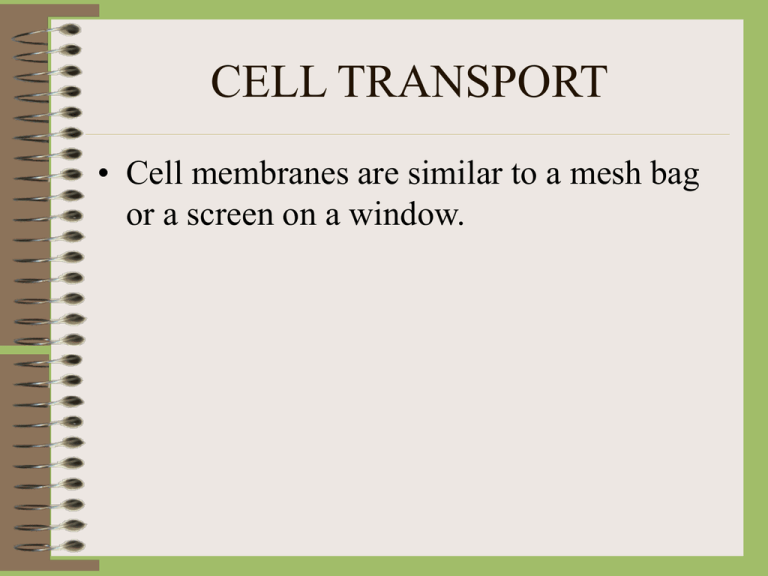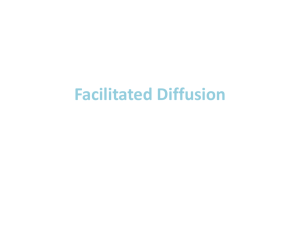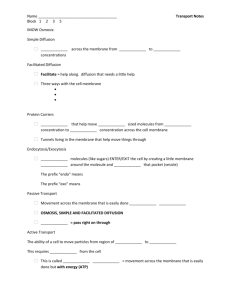Cells In Their Environment
advertisement

CELL TRANSPORT • Cell membranes are similar to a mesh bag or a screen on a window. What Does This Have To Do With Cells??? • To survive, cells must take in nutrients and eliminate waste materials. • To do this, nutrients and waste materials must cross the cell membrane between the solution outside of the cell, and the solution inside the cell. What type of Membrane? • Semi permeable membrane: allows certain molecules to pass through and prevents others from passing. Semi Permeable Cell Membrane • Small molecules like water can enter and leave the cell freely. • Larger molecules such as proteins and carbohydrates cannot enter and leave the cell freely due to their size. Transportation Processes (2) • Transport = movement of a substance across a cell membrane • Passive Transport: without energy. • Active Transport: uses energy Passive Transport (3 types) • Simple Diffusion • Facilitated Diffusion • Osmosis All three involve the movement of a substance across a cell membrane without the input of the cell’s energy. Factors To Consider (2) • Diffusion always occurs from a high concentration to a low concentration. • A concentration gradient is the difference between the concentration of a particular molecule in one area and its concentration in an adjacent area. • When molecules have been dispersed evenly, there is no concentration gradient, an equilibrium has been reached, and diffusion stops. Simple Diffusion Initially, the concentration of a substance outside the cell is higher than the inside. Later, the substance has diffused into the cell so that the concentration is the same on both sides of the membrane. If a lump of sugar is dropped into a beaker of water, the molecules dissolve (A) and diffuse (B and C). Eventually, diffusion results in an even distribution of sugar molecules throughout the water (D). Facilitated Diffusion • Molecules diffuse across a cell membrane with the HELP of carrier proteins in the membrane. • Always move from a higher level of concentration to a lower level. • Allows the glucose molecule into the blood cells. Facilitated Diffusion During facilitated diffusion, carrier proteins shuttle molecules across the lipid bilayer of the cell membrane. Facilitated Diffusion Osmosis WATER • The diffusion of water across a semi permeable membrane • Again water moves down its concentration gradient. • Moves from higher water concentration to lower water concentration. Osmosis Active Transport Uses cellular energy to move substances across the cell membrane. Against a concentration gradient – from a low concentration to a high concentration. The Sodium Potassium Pump • Active transport is especially important in maintaining the ion concentration in cells. • Ex: Animal cells pump sodium ions out and potassium ions into the cell. • High concentration of sodium ions outside of the cell. Sodium Potassium Pump Exocytosis • Moves material too big to fit through the cell membrane from a low concentration to a high concentration. • The vesicles then fuse with the cell membrane and the materials in the vesicles is secreted out of the cell. Endocytosis • The process by which a portion of the cell membrane surrounds a desirable macromolecule that is outside of the cell. Moves from a low concentration to a high concentration. • The cell then pinches off the saclike portion of its outer membrane to form a tiny new vesicle. Desired macromolecules Three tumor cells being engulfed by a white blood cell!






